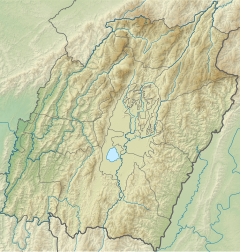River in India
| Tuivai Tuyai, Tipai | |
|---|---|
 Tuivai river in Champhai district, Mizoram Tuivai river in Champhai district, Mizoram | |
   | |
| Location | |
| Country | India (Manipur, Mizoram, Assam) |
| Physical characteristics | |
| Source | Chin Hills |
| • location | Chin State, Myanmar |
| • coordinates | 23°43′08″N 93°31′52″E / 23.719°N 93.531°E / 23.719; 93.531 |
| • elevation | 1,594 metres (5,230 ft) |
| 2nd source | Thangjing Hills |
| • location | Manipur, India |
| • coordinates | 24°25′19″N 93°38′49″E / 24.422°N 93.647°E / 24.422; 93.647 |
| • elevation | 1,594 metres (5,230 ft) |
| Mouth | Barak River |
| • location | Sipuikawn/Tipaimukh |
| • coordinates | 24°14′07″N 93°01′23″E / 24.2354°N 93.0230°E / 24.2354; 93.0230 |
| • elevation | 60 metres (200 ft) |
| Basin features | |
| Progression | Barak River |
| River system | Brahmaputra |
| Tributaries | |
| • left | Tuivel, Tuilak, Tuikui, Tuibum |
| • right | Tuila, Tuili, Tuiliam |
The Tuivai River (or Tipai River, Tuyai River) is a river that originates in Myanmar and flows through the states of Manipur, Mizoram and Assam in India. It is the longest tributary of the Barak River, into which it flows at Tipaimukh near the village Sipuikawn.
Course
The Tuivai River originates in Chin Hills in Myanmar, near the Zampi village within the Tonzang Township. It flows north and enters the Manipur state of India near the Chivu salt spring (near Behiang town). It then follows a zig-zag course winding its way through north-south running mountain ranges in the Churachandpur district of Manipur and the Champhai district of Mizoram, trending to the west. It joins the Barak River at one of its great bends at Tipaimukh ("mouth of Tipai"). Parts of the course of river as well as those of its tributaries are used as the southern border of Manipur facing Myanmar and Mizoram.
Numerous tributary streams flow into the Tuivai river from both the north and the south. The basin of these rivers essentially defines the western part of the Churachandpur district (the eastern part being in the basin of the Manipur River). After flowing 28 km north in the Churachandpur district, Tuivai makes the first of its 90-degree bends near Zabellei and turns west. Here it receives a tributary called Tuila River from the north, which originates south of the Thangjing Hills. Tuila was once considered the "Manipur source of Tuivai", but now it is regarded as a tributary. Soon Tuivai receives another tributary called Tuivel from the south, which flows parallel to the northward course of Tuivai itself.
Tuivai flows west for about 30 km, till Dyalkhai, and makes a second 90-degree bend to turn south. This location was also called Tuyai Yirok in the Manipur court chronicle Cheitharol Kumbaba. The Manipur ruler Ching-Thang Khomba (Bhagyachandra or Jai Singh) erected a stone here in 1786, to commemorate his victory over the Khongchai village of the Kuki people.
The southward course runs for about 28 km. The last 10 km of this course forms the international boundary of Manipur with Myanmar (Chin State's western border). Then the river makes a third 90-degree degree bend to turn west. At this bend, it receives the Tuisa River from the south, which also marks the boundary between Mizoram and Chin State for 28 km.
The westward course runs for about 28 km, forming the state boundary between Manipur and Mizoram. After this, Tuivai makes its fourth 90-degree bend to turn south into Mizoram. For about 20 km, it forms the district boundary between the Champhai district (to the east) and the Saitual district (to the west). After this, it makes a soft U-turn and flows back north towards Manipur.
Another 90-degree bend makes Tuivai turns west, where it forms Manipur-Mizoram state boundary for about 18 km. After this it makes its last 90-degree bend turning north towards Tipaimukh. This course, about 14 km long, also forms the state boundary between Manipur and Mizoram.
Notes
- The Khongchai village itself is north of here, in the basin of the Tuipui River.
References
- Dikshit, K. R.; Dikshit, Jutta K. (2014). North-East India: Land, People and Economy. Dordrecht: Springer. p. 136. ISBN 978-94-007-7054-6.
- Carey & Tuck, The Chin Hills (1983), p. 6.
- ^ Churachadpur District Census Handbook (2011), p. 25.
- Churachadpur District Census Handbook (2011), p. 24.
- Dun, Gazetteer of Manipur (1992).
- ^ Kuki Research Forum on objective historical position of the Kukis in Manipur, Ukhrul Times, 25 May 2022.
Bibliography
- Churachandpur District Census Handbook (PDF), Directorate of Census Operations, Manipur, 2011
- Carey, Bertram S.; Tuck, H. N. (1896), The Chin Hills, Volume I, Government Printing, Burma
- Carey, Bertram S.; Tuck, H. N. (1983) , The Chin Hills, Volume I, Cultural Publishing House
- Dun, E. W. (1992) , Gazetteer of Manipur, Manas Publications – via archive.org
- Pau, Pum Khan (2019), Indo-Burma Frontier and the Making of the Chin Hills: Empire and Resistance, Taylor & Francis, ISBN 9781000507454
External links
- Tuivai River, OpenStreetMap, retrieved 20 August 2023.
- Tuivai River basin, OpenStreetMap, retrieved 20 February 2024.
| Hydrography of Manipur | |
|---|---|
| Rivers | |
| Lakes | |
| Dams | |
| Hydrography of Mizoram | |
|---|---|
| Rivers | |
| Lakes | |
| Waterfalls | |
| Dams | |
| Related topics | |